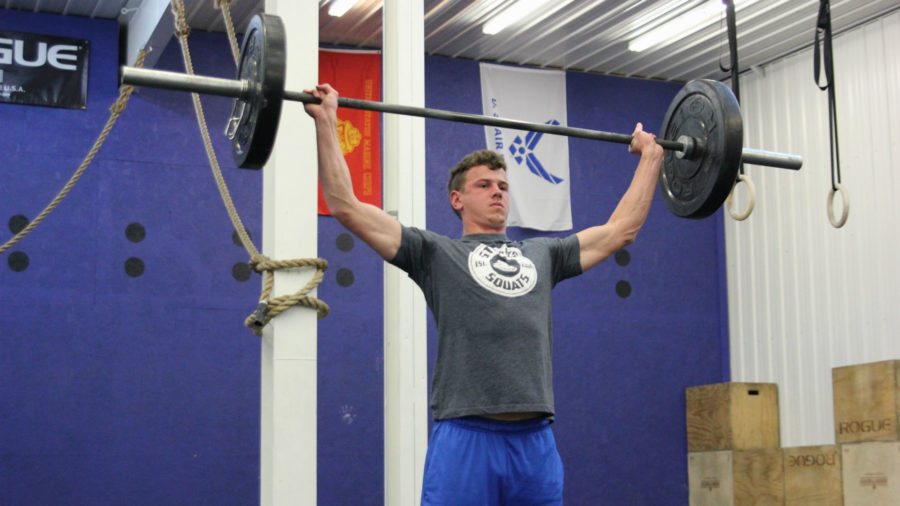Collegiate ‘CrossFitters’ at Simpson
April 7, 2016
In 2005, CrossFit was still only in its infancy stages. The high-intensity, Olympic-style lifting regimen only had 13 gyms supporting its name at the time.
Now, there are over 13,000 CrossFit gyms throughout the United States. National competitions are being hosted every year, including the “CrossFit Games.”
The workout trend has reached the small town of Indianola and Simpson College, having crept into the exercise plan of a handful of students.
While it’s somewhat unknown and clouded in controversy, here is what CrossFit has done for these students and what it could mean for student-athletes looking for a competitive edge after graduation.
What is CrossFit?
CrossFit.com defines CrossFit as “constantly varied functional movements performed at relatively high intensity. All CrossFit workouts are based on functional movements, and these movements reflect the best aspects of gymnastics, weightlifting, running, rowing and more. These are the core movements of life.”
CrossFit is unlike conventional weight lifting and exercise. It features High Intensity Interval Training (HIIT) and centers on multi-joint lifts, as opposed to the body part isolated lifts dominating weight rooms.
“In CrossFit, it’s constantly your whole body, whereas I was very body group oriented before,” junior Jordan Ukena said. “Like, I didn’t know I had to strengthen my back in order to lift myself up for a pull-up.”
Why did you join CrossFit?
For senior Katie Kieffer, her mom was the influence that got her into CrossFit. Coming into Simpson, Kieffer planned on playing volleyball and wanted to be able to prepare for the college game.
“I was planning on playing a collegiate sport when I was a senior in high school and needed a way to get stronger,” Kieffer said. “My mom searched for a trainer in my hometown and found a CrossFit gym…my mom is my biggest influence on me because she works harder than anyone I know and is a total stud.”
Senior soccer player Drew Johnston was also influenced by his brother and sophomore track athlete Tate Tufte was brought onto the regime by 2015 Simpson graduate Josh Diehm.
Ukena simply needed a change of pace in her workouts.
“I started losing my self-motivation because I didn’t have a [workout] partner,” Ukena said. “I needed to get my motivation going again, so I needed to get that group motivation growing again.”
The CrossFit Community
Many of the CrossFitters at Simpson train at the “CrossFit 65/69” gym on the south side of Indianola on Jefferson Ave.
The exercises and workouts have shown results for people of all ages, but the community has been the greatest benefit.
“In my first workout, I was last in my class,” Tufte said. “The cool thing about it is that, even though I was last, nobody left. I was still going and the owner and three other people were next to me and cheering me on to keep going. That was awesome right off the bat.”
Tufte is now certified to teach CrossFit.
The gym in Indianola has a steep fee around $95, so some have shied away from the price and have made do with the equipment in the Steven Johnson Fitness Center.
What does a workout look like?
Maybe you’ve seen the CrossFit Games on television, but the “average” CrossFitter will warn you that’s not the norm for the type of workout you’ll do.
Those who do CrossFit follow the “WoD,” known as the workout of the day. Each day it’s different and will include a variety of warm-ups, an Olympic lift and often a 12-minute AMRAP (as many rounds/reps as possible).
Two thrusters (105 pounds for females, 155 pounds for males)
Two rope climbs (15 feet)
Five box jumps (24 inches for females, 30 inches for males)
Ukena referenced using an app called “Wodify” which links each member of a particular gym in a group to list their results in completing the “WoD,” adding another dimension to the communal aspect of CrossFit.
What’s the benefit?
Johnston, who suffered some soft tissue injuries during his soccer career at Simpson, has seen CrossFit as a way to make himself more flexible and less prone to injury.
“Mobility is definitely a benefit,” Johnston said. “I am not a naturally flexible person, but there are a lot of things and movements that require you to be flexible in CrossFit, so the focus to that, which I haven’t had, is going to keep me injury free.”
The mental climb each WoD brings is enough to put anyone into a “dark state mentally” as Johnston put it. CrossFit adds a mental edge that conventional lifting hasn’t for some.
“I wasn’t really the most confident in what I did,” sophomore Jake Gibney said. “But now, even outside of lifting I am more confident in what I do. I also feel motivated to push myself further than what I can already do to see what else I can accomplish.”
Getting past the stigmas
One of the biggest misconceptions about CrossFit is that those who do it are very prone to injury due to stressful overhead lifts.
Like anything, form is essential to avoid that.
“We were talking in physics class the other day, and a couple of exercise science kids were voicing their opinions saying, ‘You’re just going to get hurt,’” Ukena said. “It’s your own fault if you get hurt and are stubborn when injured.”
Sometimes the intimidation factor keeps people from CrossFit when the nature of the workouts are tailored to each person’s level of strength, fitness and flexibility.
“So many people tell me that they need to get in shape before they try CrossFit because it’s intense,” Kieffer said. “The truth is, anyone and everyone can do CrossFit because it is such a unique way to training. There are so many ways to modify workouts.”






